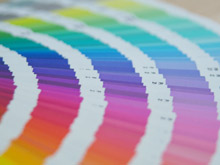Marketing Guides
Creative & Brand Development
How to Choose Your Colors
 If your business were a color, what would it be? Red? Blue? Brown? Green?
If your business were a color, what would it be? Red? Blue? Brown? Green?
Many entrepreneurs and established companies have trouble choosing colors. A designer may present a series of logos in a variety of colors. And all too often the team will choose the colors that they like best.
But choosing a color isn’t about what you like. It’s about what your company stands for.
Color carries incredible psychological power. You probably know that celebrities sit in a green room before performances and that McDonald’s uses orange to stimulate your appetite.
Therefore, instead of choosing your favorites, choose colors that support your brand promise and your company’s personality. For example, if you stand for innovation, choose red, orange or yellow — don’t use a traditional color like navy or a simple color like brown.
Seem obvious? It becomes more obvious when you have a clear vision of your value proposition and brand promise. (More about branding.)
What about using multiple colors? Color is most powerful in large doses; however, you can use two colors to add interest and depth. Just make sure they convey what you need to convey. Beyond that you start to neutralize the impact of your primary color.
Understand the Psychological Impact When You Choose Your Colors
Here are some traditional meanings of popular colors:
| Navy | A masculine color associated with depth, expertise, and stability. It’s a preferred color for corporate America. |
| Blue | Associated with tranquility and calmness. The color of the sky and water, it symbolizes sincerity, trust, wisdom and truth. |
| Green | The color of nature. It symbolizes harmony, safety, growth, freshness, and fertility. It’s a restful color that suggests stability and endurance. |
| Red | An emotionally intense color. It’s associated with energy, strength, power, danger, and passion. It’s highly visible and enhances human metabolism, increases respiration, and raises blood pressure. |
| Orange | Combines the energy of red and the happiness of yellow. It’s associated with enthusiasm, joy, stimulation, attraction, creativity and health. It’s considered a sporty color. |
| Yellow | The color of sunshine, yellow produces a warming effect, arouses cheerfulness, stimulates mental activity, and generates muscle energy. It’s associated with joy, happiness, vibrancy, intellect and energy. |
| Purple | A unique color that combines the stability of blue and energy of red. Generally associated with royalty, purple symbolizes luxury, wealth, power, and dignity. |
| Brown | The color of earth. It’s associated with genuineness, simplicity, dependability, and friendliness. |
| Black | Associated with power, mystery, elegance, strength and formality. Black can be very formal, elegant and prestigious; it adds depth when combined with other colors. |
| Gray/silver | Has similar connotations to black, evoking dignity, wisdom, and responsibility. |
| Gold | Associated with success, money and wealth; it can evoke comfort and quality. |
Once you’ve selected your color theme, you’ll need to choose PMS, CMYK, RGB and HEX color formulas:
- PMS = Pantone Matching System: Ink colors. If you’re printing only two colors on your business cards, your printer will probably use your two PMS color inks.
- CMYK: The formula for creating the color using a combination of cyan, magenta, yellow and black ink during four-color printing.
- RGB: This formula is used in electronic documents – it’s the amount of red, green and blue used to create the color.
- HEX: A color code used in HTML programming for your website.
It can be difficult to match your chosen look in different printing & electronic mediums, but a professional designer can help you choose the closest formulas.
BRANDING TEMPLATES / MARKETING PLANS / PROJECT MANAGEMENT
EVERYTHING YOU NEED FOR YOUR BRANDING PROJECT